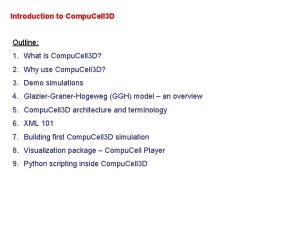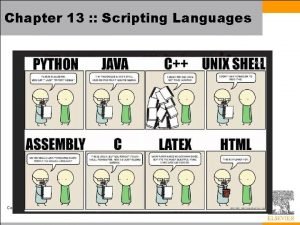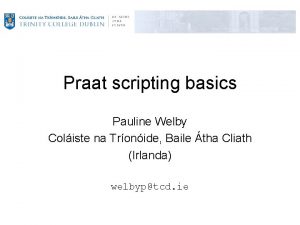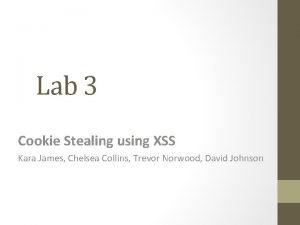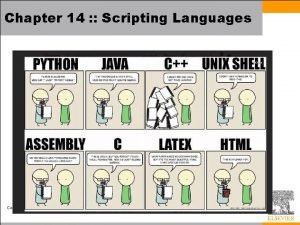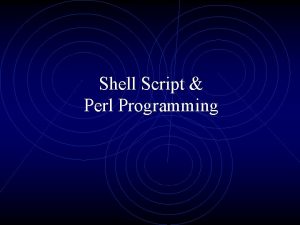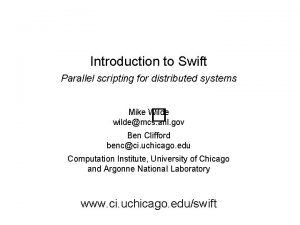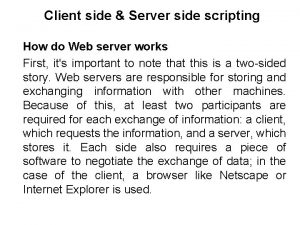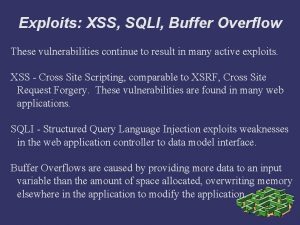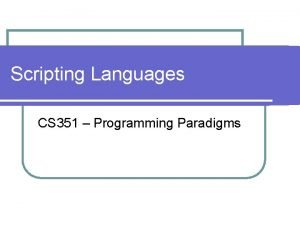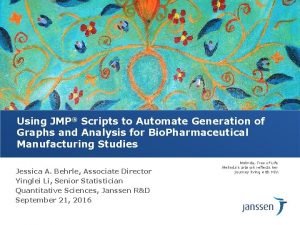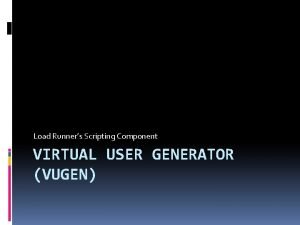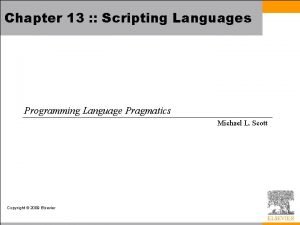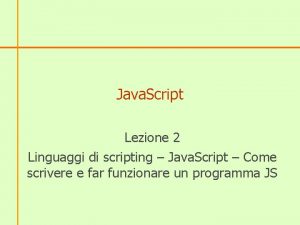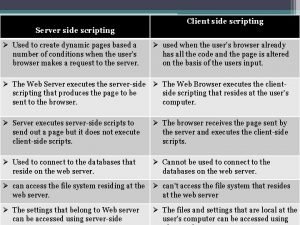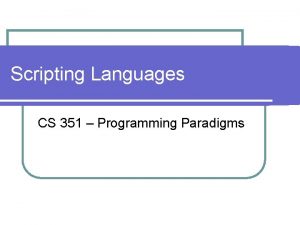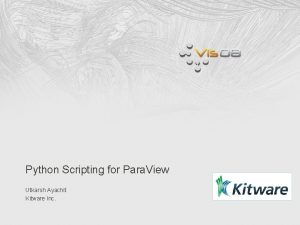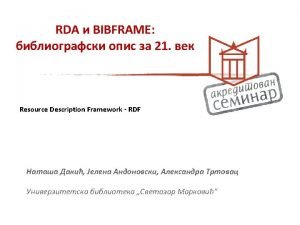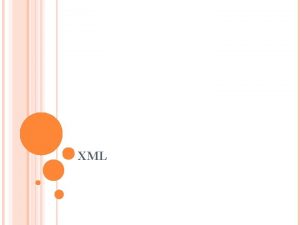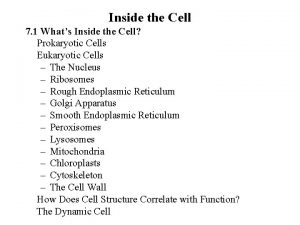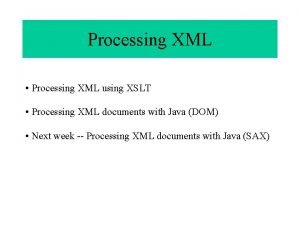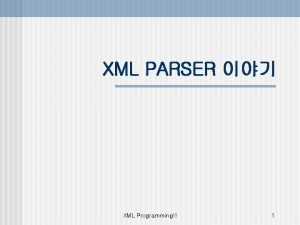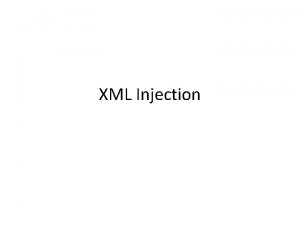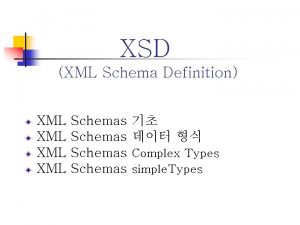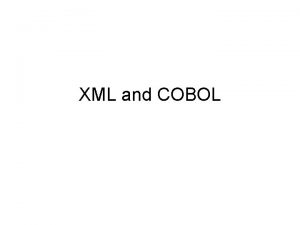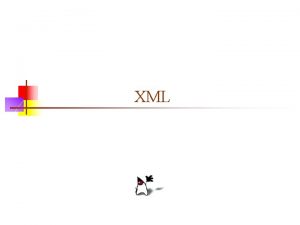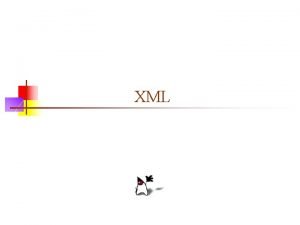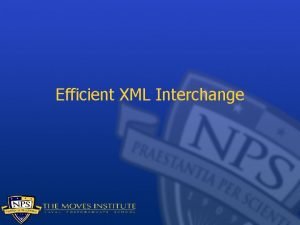scripting inside Compu Cell 3 D XML gives










































































- Slides: 74

scripting inside Compu. Cell 3 D • XML gives you the ability to change simulation parameters using human-readable syntax but does not allow users to implement more complex cell behaviors, sophisticated cell type transition rules, inter-cell signaling or connecting to intracellular models • Python scripting capabilities in Compu. Cell 3 D allow users to accomplish abovementioned tasks (and much more) and are the reasons why Compu. Cell 3 D is called simulation environment, not simulation application. • Python scripting capabilities allow users to use rich set of Python modules and third party libraries and provide level flexibility comparable with packages such as Matlab or Mathematica

Python Scripting Prerequisites • To make full use of Python scripting users should be familiar with Python programming language. They do not need to be experts though. • Compu. Cell 3 D comes with template and example codes that make Python scripting inside Compu. Cell 3 D quite easy even for beginners. • Python scripting in Compu. Cell 3 D typically requires users to develop a class that implements required logic. If you are unfamiliar with concept of class , think of it as a type that has several data members (such as floats, integers, other classes) and set of functions that operate on those internal members but can also take external arguments. Class is a generalization of “C” structure or “Pascal” record. • Fortunately Compu. Cell 3 D comes with plenty of examples that users can adapt to serve their needs. This does not require thorough programming knowledge. If you are unfamiliar with Python scripting, reading (and doing) “Compu. Cell 3 D Python Scripting Tutorials” should quickly get you up-to-speed.

Typical example when Python proves to be very useful Start with a small cell that grows It reaches “doubling volume” … and divides into two cells After mitosis you want to specify types of parent and daughter cells. You may want to change target surface and target volume of daughter. And target volume is a function of a FGF concentration at the center of mass of the daughter cell. How would you do it from just XML? Python seems to be the best solution for problems like this one

Where Do You Begin? • Early version of Python scripting in Compu. Cell 3 D required users to provide CC 3 DML configuration file. This is no longer true. You can describe entire simulation from Python level. However, you may still use XML and Python if you want. The choice is up to you. • You will need to write Python script that implements main Compu. Cell 3 D logic i. e. reads CC 3 DML file (if you are using CC 3 DML file), initializes modules and executes calls in a loop Metropolis algorithm. This file will also call set up and initialize your modules written in Python. Compu. Cell 3 D comes with many examples of such files so in fact preparing one is reduced to minor modification of existing one. • Once you have Python script (and optionally CC 3 DML file) ready, you open them up in the Player and start running simulations.

What Can You Do in Python? • You may implement any Compu. Cell 3 D module using Python – energy functions, lattice monitors, steppers, steppables, fixed steppers. • You need to remember that Python is an interpreted language and thus executes orders of magnitudes slower than, for example, C++. This means that although you can easily develop energy functions (remember, they are the most frequently called modules in Compu. Cell 3 D) in Python, you will probably want to avoid using them with your “production runs”. In this it makes sense to implement those functions in C++ , which is not too difficult and we provide comprehensive Developers documentation. • Since lattice monitors are called less frequently than energy functions, the performance degradation due to lattice monitor being implemented in Python is much smaller. That same is true for steppers, fixed steppers and steppables. • Notice that Compu. Cell 3 D kernel that is called from Python, as well as other core Compu. Cell 3 D modules called from Python run at native speeds, as they are implemented in C++ with only their API exposed to Python. Therefore if you run Compu. Cell 3 D through Python script but decide not to implement new Python modules, your speed of run will be essentially identical as if you ran Compu. Cell 3 D using just CC 3 DML file.

What are the advantages of using Python inside Compu. Cell 3 D • Rapid development – no compilation is necessary. Write or modify your script and run • Portability – script developed by you on one machine (e. g. Mac) is ready to use under linux • Model integration - you can quite easily implement hooks to subcellular models. We have been able to set up Compu. Cell 3 D simulation that was using SBW network intracell simulators within few minutes. T • Rich set of external libraries – you may tap into rich Python library repositories that exist for essentially any task • Agile development – developing and refining your model is an iterative process. Working at the compiled language stage will force you to spend significant portion of your time waiting for the program to compile. With Python you eliminate this step thus increase productivity. Users should first prototype their models in Python and once they are ready to be used for production runs, rewrite the ones causing significant slowdown in C++.

You need to remember this: Python distinguishes blocks of codes by their indentation. Therefore for a in xrange(0, 5): print “variable a=“, a print " Final value of variable a is …“ , a would result in an error because the line print " Final value of variable a=", a has different indentation than other print statement and thus does belong to the “for” loop. Python will attempt executing this line once after the “for” loop is finished and will return an error that global object “a” was not found. It was found because “a” name is valid only inside the “for” loop body. Since the last line was not in the body, you get an error. We are using 4 spaces to indent block of codes, you may choose differently, but need to be consistent. HOWEVER 4 space indentation is a de-facto standard among Python programers so we strongly recommend you adhere to it

Your first Compu. Cell 3 D Python script. Make sure you have your copy of Python Scripting Tutorials Begin with template code (the file will be called cellsort_2 D. py) #import useful modules import sys from os import environ from os import getcwd import string #setup search paths sys. path. append(environ["PYTHON_MODULE_PATH"]) import Compu. Cell. Setup. set. Simulation. XMLFile. Name("examples_Python. Tutorial/cellsort_2 D. xml" sim, simthread = Compu. Cell. Setup. get. Core. Simulation. Objects() #Create extra player fields here or add attributes Compu. Cell. Setup. initialize. Simulation. Objects(sim, simthread) #Add Python steppables here steppable. Registry=Compu. Cell. Setup. get. Steppable. Registry() Compu. Cell. Setup. main. Loop(sim, simthread, steppable. Registry)

Bacterium and macrophage simulation def configure. Simulation(sim): import Compu. Cell. Setup from XMLUtils import Element. CC 3 D cc 3 d=Element. CC 3 D("Compu. Cell 3 D") potts=cc 3 d. Element. CC 3 D("Potts") potts. Element. CC 3 D("Dimensions", {"x": 100, "y": 100, "z": 1}) potts. Element. CC 3 D("Steps", {}, 10000) potts. Element. CC 3 D("Temperature", {}, 15) potts. Element. CC 3 D("Neighbor. Order", {}, 2) cell. Type=cc 3 d. Element. CC 3 D("Plugin", {"Name": "Cell. Type"}) cell. Type. Element. CC 3 D("Cell. Type", {"Type. Name": "Medium", "Type. Id": "0"}) cell. Type. Element. CC 3 D("Cell. Type", {"Type. Name": "Bacterium", "Type. Id": "1"}) cell. Type. Element. CC 3 D("Cell. Type", {"Type. Name": "Macrophage", "Type. Id": "2"}) cell. Type. Element. CC 3 D("Cell. Type", {"Type. Name": "Wall", "Type. Id": "3" , "Freeze": ""}) volume=cc 3 d. Element. CC 3 D("Plugin", {"Name": "Volume"}) volume. Element. CC 3 D("Target. Volume", {}, 25) volume. Element. CC 3 D("Lambda. Volume", {}, 15. 0) surface=cc 3 d. Element. CC 3 D("Plugin", {"Name": "Surface"}) surface. Element. CC 3 D("Target. Surface", {}, 20) surface. Element. CC 3 D("Lambda. Surface", {}, 4. 0)

Continued… contact=cc 3 d. Element. CC 3 D("Plugin", {"Name": "Contact"}) contact. Element. CC 3 D("Energy", {"Type 1": "Medium", "Type 2": "Medium"}, 0) contact. Element. CC 3 D("Energy", {"Type 1": "Macrophage", "Type 2": "Macrophage"}, 15) contact. Element. CC 3 D("Energy", {"Type 1": "Macrophage", "Type 2": "Medium"}, 8) contact. Element. CC 3 D("Energy", {"Type 1": "Bacterium", "Type 2": "Bacterium"}, 15) contact. Element. CC 3 D("Energy", {"Type 1": "Bacterium", "Type 2": "Macrophage"}, 15) contact. Element. CC 3 D("Energy", {"Type 1": "Bacterium", "Type 2": "Medium"}, 8) contact. Element. CC 3 D("Energy", {"Type 1": "Wall", "Type 2": "Wall"}, 0) contact. Element. CC 3 D("Energy", {"Type 1": "Wall", "Type 2": "Medium"}, 0) contact. Element. CC 3 D("Energy", {"Type 1": "Wall", "Type 2": "Bacterium"}, 50) contact. Element. CC 3 D("Energy", {"Type 1": "Wall", "Type 2": "Macrophage"}, 50) chemotaxis=cc 3 d. Element. CC 3 D("Plugin", {"Name": "Chemotaxis"}) chemical. Field=chemotaxis. Element. CC 3 D("Chemical. Field", {"Source": "Flexible. Diffusion. Solver. FE", "Name": "ATTR"}) chemical. Field. Element. CC 3 D("Chemotaxis. By. Type", {"Type": "Macrophage" , "Lambda": 200})

Continued… flex. Diff. Solver=cc 3 d. Element. CC 3 D("Steppable", {"Type": "Flexible. Diffusion. Solver. FE"}) diffusion. Field=flex. Diff. Solver. Element. CC 3 D("Diffusion. Field") diffusion. Data=diffusion. Field. Element. CC 3 D("Diffusion. Data") diffusion. Data. Element. CC 3 D("Field. Name", {}, "ATTR") diffusion. Data. Element. CC 3 D("Diffusion. Constant", {}, 0. 10) diffusion. Data. Element. CC 3 D("Decay. Constant", {}, 0. 0) diffusion. Data. Element. CC 3 D("Do. Not. Diffuse. To", {}, "Wall") secretion. Data=diffusion. Field. Element. CC 3 D("Secretion. Data") secretion. Data. Element. CC 3 D("Secretion", {"Type": "Bacterium"}, 200) pif. Initializer=cc 3 d. Element. CC 3 D("Steppable", {"Type": "PIFInitializer"}) pif. Initializer. Element. CC 3 D("PIFName", {}, "Demos/Python. Only. Simulations. Examples/bacterium_macrophage_2 D_wall. pif") # next line is very important and very easy to forget about. It registers XML description and points # CC 3 D to the right XML file (or XML tree data structure in this case) Compu. Cell. Setup. set. Simulation. XMLDescription(cc 3 d)

Beyond XML - Developing Python Steppables Examples presented above showed how to run Python based simulations and how to replace XML with Python. However, the true power of Python is demonstrated in the case when you develop your own modules. We will first teach you how to develop a steppable because steppables are most likely to be developed in Python anyway. Let’s take a look at the module that prints cell id, cell type and cell volume for every cell in the simulation. Iterating over all cells is probably most frequently used task in steppables: class Info. Printer. Steppable(Steppable. Py): def __init__(self, _simulator, _frequency=10): Steppable. Py. __init__(self, _frequency) self. simulator=_simulator self. inventory=self. simulator. get. Potts(). get. Cell. Inventory() self. cell. List=Cell. List(self. inventory) def start(self): print "This function is called once before simulation" def step(self, mcs): print "This function is called every 10 MCS“ for cell in self. cell. List: print "CELL ID=", cell. id, " CELL TYPE=", cell. type, " volume=", cell. volume

Python Steppable Each Python Steppable should have three functions: start() step(mcs) finish() It is OK to leave out the implementation of any of above functions empty (or simply pretend they do not exist). An empty function will be then called. In addition to this, because Python steppables are implemented as classes they need to define __init__ function that acts as a constructor. Steppable Template: class Your. Python. Steppable(Steppable. Py): def __init__(self, _simulator, _frequency=10): #your code here def start(self): #your code here def step(self, mcs): #your code here def finish(self): #your code here

If you are non-programmer it may looks a bit strange, but imagine how much more would be required to write do the same in C/C++. Much more. Let’s explain the code: class Info. Printer. Steppable(Steppable. Py): def __init__(self, _simulator, _frequency=10): Steppable. Py. __init__(self, _frequency) self. simulator=_simulator self. inventory=self. simulator. get. Potts(). get. Cell. Inventory() self. cell. List=Cell. List(self. inventory) • First line defines our steppable class. Each class has to have __init__method that is called when object of this class is created. You can pass any arguments to this method, but the first argument must be “self”. This is required by Python language. • First line in __init__ method initializes Base class Steppable. Py. Do not worry if you do not understand it. Treat it as a boiler plate code. • Line self. simulator=_simulator stores a pointer (reference) to simulator object as a member variable. This way, later on whenever we decide to reference simulator we would use self. simmulator instead of getting simulator some other , more complicated way. Notice, that whenever you access member variable you prepend their name with keyword “self” Subsequently we get reference to cell inventory (C++ object) and use it to create iterable cell. List (self. cell. List=Cell. List(self. inventory)) Notice, “self” shows up again.

def step(self, mcs): print "This function is called every”, self. frequency, ” MCS“ for cell in self. cell. List: print "CELL ID=", cell. id, " CELL TYPE=", cell. type, " volume=", cell. volume • Above function implements core functionality of our steppable. It informs that it is called every 10 MCS – see how we set frequency parameter in the __init__ function. • The last two lines do actual iteration over each cell in the cell inventory • Notice that it is really easy to do the iteration: for cell in self. cell. List: • Now you can see how storing Cell. Type object as self. cell. List comes handy. All we need to do is to pass iterable cell list (self. cell. List) to the “for” loop. Actual printing is done in line print "CELL ID=", cell. id, " CELL TYPE=", cell. type, " volume=", cell. volume • For each cell in inventory “cell” variable of the for loop will be initialized with different cell from inventory. All you need to do is to print cell. id, cell. type, and cell. volume. It is pretty simple.

Now save the file with the steppable as , cellsort_2 D_steppables. py. All you need to do is to provide hooks to your steppable in the main Python script: steppable. Registry=Compu. Cell. Setup. get. Steppable. Registry() ##### Steppable Registration ###### from cellsort_2 D_steppables import Info. Printer. Steppable info. Printer= Info. Printer. Steppable(sim) steppable. Registry. register. Steppable(info. Printer) #####End of Steppable Registration ###### steppable. Registry. init(sim) Notice that registering steppable requires importing your steppable from the file: from cellsort_2 D_stepables import Info. Printer. Steppable creating steppable object: info. Printer= Info. Printer. Steppable(sim) registering it with steppable registry: steppable. Registry. register. Steppable(info. Printer)

Full Main Script (examples_Python. Tutorial/cellsort_2 D_info_printer. py): #import useful modules import sys from os import environ from os import getcwd import string #setup search paths sys. path. append(environ["PYTHON_MODULE_PATH"]) sys. path. append(getcwd()+"/examples_Python. Tutorial") #add search path import Compu. Cell. Setup # tell CC 3 D that you will use CC 3 DML file together with current Python script Compu. Cell. Setup. set. Simulation. XMLFile. Name ("examples_Python. Tutorial/cellsort_2 D_info_printer/cellsort_2 D. xml") sim, simthread = Compu. Cell. Setup. get. Core. Simulation. Objects() #Create extra player fields here or add attributes Compu. Cell. Setup. initialize. Simulation. Objects(sim, simthread) #Add Python steppables here steppable. Registry=Compu. Cell. Setup. get. Steppable. Registry() from cellsort_2 D_steppables import Info. Printer. Steppable info. Printer. Steppable=Info. Printer. Steppable(_simulator=sim, _frequency=10) steppable. Registry. register. Steppable(info. Printer. Steppable) Compu. Cell. Setup. main. Loop(sim, simthread, steppable. Registry)

Useful shortcut – simplifying steppable definition: class Info. Printer. Steppable(Steppable. Base. Py): def __init__(self, _simulator, _frequency=10): Steppable. Base. Py. __init__(self, _simulator, _frequency) def start(self): print "This function is called once before simulation" def step(self, mcs): print "This function is called every 10 MCS“ for cell in self. cell. List: print "CELL ID=", cell. id, " CELL TYPE=", cell. type, " volume=", cell. volume Notice that we have used as a base class Steppable. Base. Py instead of Steppable. Py. Steppable. Base. Py already contains members and initializations for: self. cell. List self. simulator self. potts self. cell. Field self. dim self. inventory

Steppable. Base. Py: class Steppable. Base. Py(Steppable. Py): def __init__(self, _simulator, _frequency=1): Steppable. Py. __init__(self, _frequency) self. simulator=_simulator self. potts=_simulator. get. Potts() self. cell. Field=self. potts. get. Cell. Field. G() self. dim=self. cell. Field. get. Dim() self. inventory=self. simulator. get. Potts(). get. Cell. Inventory() self. cell. List=Cell. List(self. inventory)

Now, all you need to do is to open in the Player newly created cellsort_2 D_info_printer. py. Notice that you are not loading directly cellsort_2 D_steppables. py file. The module you stored to this file will be called from cellsort_2 D_info_printer. py. Try running the simulation and see if you got any performance degradation. Probably not, but by using Python you have saved yourself a lot of tedious C++ coding, not to mention that you do not need to care about dependencies, compilation, etc. . Writing your next Python steppable will require much less effort as well, as you will quickly discover that you will be using same basic code template over and over again. Instead of thinking how the code you are writing fits in the overall framework you will just concentrate on it’s core functionality and leave the rest to Compu. Cell 3 D. In case you wonder how this is all possible , it is due to Object Oriented programming. Hopefully this short tutorial will encourage you to learn more of object oriented programming. It is really worth the effort.

Info Printer results

Python Scripting Checklist: 1. Write main Python script (modify or reuse existing one) 2. Write Python modules in a separate file. You will import these modules from main Python script 3. Provide CC 3 DML configuration file or describe entire simulation in Python skipping CC 3 DML entirely Note: when using Python scripting your simulation may consists of many files. Make sure you keep track of them

More Complicated Simulations – Adding Extra Attribute To a Cell In Compu. Cell 3 D simulations each cell by default will have several attributes such as volume, surface, centroids , target volume, cell id etc. One can write a plugin that attaches additional attributes to a cell during run time. Doing so avoids recompilation of entire Compu. Cell 3 D but requires to write and compile the C++ plugin. It is by far the easiest to attach additional cell attribute in Python. Not only there is no need to recompile anything, but the actual task takes one line of code: py. Attribute. Adder, list. Adder=Compu. Cell. Setup. attach. List. To. Cells(sim) Above we told Compu. Cell 3 D to attach a Python list to each cell that will be produced by the Compu. Cell 3 D kernel. We can access this list very easily from Python level. Python list is dynamic data structure that can grow or shrink and can hold arbitrary Python objects. Therefore by attaching a list to each cell we effectively came up with a way to attach any cell attribute. We may also attach dictionary instead of the list: py. Attribute. Adder, dict. Adder=Compu. Cell. Setup. attach. Dictionary. To. Cells(sim) And everything takes place during run time…

Full listing of simulation where each cell gets extra attribute – a list: import sys from os import environ from os import getcwd import string sys. path. append(environ["PYTHON_MODULE_PATH"]) sys. path. append(getcwd()+"/examples_Python. Tutorial") import Compu. Cell. Setup. set. Simulation. XMLFile. Name("examples_Python. Tutorial/cellsort_2 D_extra_attrib/cellsort_2 D. xml") sim, simthread = Compu. Cell. Setup. get. Core. Simulation. Objects() #Create extra player fields here or add attributes py. Attribute. Adder, list. Adder=Compu. Cell. Setup. attach. List. To. Cells(sim) Compu. Cell. Setup. initialize. Simulation. Objects(sim, simthread) #Add Python steppables here steppable. Registry=Compu. Cell. Setup. get. Steppable. Registry() #here we will add Extra. Attribute. Cellsort steppable from cellsort_2 D_steppables import Extra. Attribute. Cellsort extra. Attribute. Cellsort=Extra. Attribute. Cellsort(_simulator=sim, _frequency=10) steppable. Registry. register. Steppable(extra. Attribute. Cellsort) from cellsort_2 D_steppables import Type. Switcher. Steppable type. Switcher. Steppable=Type. Switcher. Steppable(sim, 100) steppable. Registry. register. Steppable(type. Switcher. Steppable) Compu. Cell. Setup. main. Loop(sim, simthread, steppable. Registry)

Extra. Attribute. Cellsort class Extra. Attribute. Cellsort(Steppable. Py): def __init__(self, _simulator, _frequency=10): Steppable. Py. __init__(self, _frequency) self. simulator=_simulator self. inventory=self. simulator. get. Potts(). get. Cell. Inventory() self. cell. List=Cell. List(self. inventory) def step(self, mcs): for cell in self. cell. List: py. Attrib=Compu. Cell. get. Py. Attrib(cell) py. Attrib[0: 2]=[cell. id*mcs , cell. id*(mcs-1)] print "CELL ID modified=", py. Attrib[0], " ", py. Attrib[1] Initializing first two elements of the list Notice, you may also attach a dictionary to a cell instead of a list. See Python Scripting Tutorials for more information. Dictionaries are actually more useful then lists in the Compu. Cell 3 D context so make sure you understand them and know how to attach them to cells.

Extra. Attrib results

Type. Switcher. Steppable class Type. Switcher. Steppable(Steppable. Py): def __init__(self, _simulator, _frequency=100): Steppable. Py. __init__(self, _frequency) self. simulator=_simulator self. inventory=self. simulator. get. Potts(). get. Cell. Inventory() self. cell. List=Cell. List(self. inventory) def step(self, mcs): for cell in self. cell. List: if cell. type==1: cell. type=2 elif (cell. type==2): cell. type=1 else: print "Unknown type. In cellsort simulation there should only be two types ”, “ 1 and 2" Line continuation in Python

Accessing Neighbor. Tracker from Python As you remember from lectures on CC 3 DML configuration files, Compu. Cell 3 D can track cell neighbors. You can access information about cell neighbors directly from Python: class Neighbor. Tracker. Printer. Steppable(Steppable. Py): def __init__(self, _simulator, _frequency=100): Steppable. Py. __init__(self, _frequency) self. simulator=_simulator self. n. Tracker. Plugin=Compu. Cell. get. Neighbor. Tracker. Plugin() self. inventory=self. simulator. get. Potts(). get. Cell. Inventory() self. cell. List=Cell. List(self. inventory) def start(self): pass def step(self, mcs): self. cell. List=Cell. List(self. inventory) for cell in self. cell. List: cell. Neighbor. List=Cell. Neighbor. List. Auto(self. n. Tracker. Plugin, cell) #create local neighbor list print "*****NEIGHBORS OF CELL WITH ID ", cell. id, " *********" for neighbor. Surface. Data in cell. Neighbor. List: #iterate over local neighbor list if neighbor. Surface. Data. neighbor. Address: #check if neighbor is non-Medium print "neighbor. id", neighbor. Surface. Data. neighbor. Address. id, " common. Surface. Area=", neighbor. Surface. Data. common. Surface. Area #access common surface area and id else: print "Medium common. Surface. Area=", neighbor. Surface. Data. common. Surface. Area

Understanding iteration over cell neighbors def step(self, mcs): self. cell. List=Cell. List(self. inventory) for cell in self. cell. List: cell. Neighbor. List=Cell. Neighbor. List. Auto(self. n. Tracker. Plugin, cell) print "*****NEIGHBORS OF CELL WITH ID ", cell. id, " *********" for neighbor. Surface. Data in cell. Neighbor. List: if neighbor. Surface. Data. neighbor. Address: print "neighbor. id", neighbor. Surface. Data. neighbor. Address. id, " common. Surface. Area=", neighbor. Surface. Data. common. Surface. Area else: print "Medium common. Surface. Area=", neighbor. Surface. Data. common. Surface. Area Iterating over all cells in the simulation This function constructs list of cell neighbors neighbor. Surface. Data object has neighbor. Address and common. Surface. Area members. The first one stores a pointer to a neighbor cell, the second stores sommon surface area between neighbors

import sys from os import environ from os import getcwd import string sys. path. append(environ["PYTHON_MODULE_PATH"]) sys. path. append(getcwd()+"/examples_Python. Tutorial") import Compu. Cell. Setup. set. Simulation. XMLFile. Name("examples_Python. Tutorial/cellsort_2 D_ne ighbor_tracker/cellsort_2 D_neighbor_tracker. xml") sim, simthread = Compu. Cell. Setup. get. Core. Simulation. Objects() #Create extra player fields here or add attributes py. Attribute. Adder, list. Adder=Compu. Cell. Setup. attach. List. To. Cells(sim) Compu. Cell. Setup. initialize. Simulation. Objects(sim, simthread) #Add Python steppables here steppable. Registry=Compu. Cell. Setup. get. Steppable. Registry() from cellsort_2 D_steppables import Neighbor. Tracker. Printer. Steppable neighbor. Tracker. Printer. Steppable=Neighbor. Tracker. Printer. Steppable(sim, 100) steppable. Registry. register. Steppable(neighbor. Tracker. Printer. Steppable) Compu. Cell. Setup. main. Loop(sim, simthread, steppable. Registry)

Neighbor. Tracker printouts

Printing values of the concentration to a file import sys from os import environ from os import getcwd import string sys. path. append(environ["PYTHON_MODULE_PATH"]) sys. path. append(getcwd()+"/examples_Python. Tutorial") import Compu. Cell. Setup. set. Simulation. XMLFile. Name("examples_Python. Tutorial/diffusion_2 D. xml") sim, simthread = Compu. Cell. Setup. get. Core. Simulation. Objects() #Create extra player fields here or add attributes Compu. Cell. Setup. initialize. Simulation. Objects(sim, simthread) #Add Python steppables here from Py. Steppables. Examples import Steppable. Registry steppable. Registry=Steppable. Registry() from cellsort_2 D_steppables import Concentration. Field. Dumper. Steppable concentration. Field. Dumper. Steppable=Concentration. Field. Dumper. Steppable(sim, _frequency=100) concentration. Field. Dumper. Steppable. set. Field. Name("FGF") steppable. Registry. register. Steppable(concentration. Field. Dumper. Steppable) Compu. Cell. Setup. main. Loop(sim, simthread, steppable. Registry)

class Concentration. Field. Dumper. Steppable(Steppable. Py): def __init__(self, _simulator, _frequency=1): Steppable. Py. __init__(self, _frequency) self. simulator=_simulator self. dim=self. simulator. get. Potts(). get. Cell. Field. G(). get. Dim() def set. Field. Name(self, _field. Name): self. field. Name=_field. Name def step(self, mcs): file. Name=self. field. Name+"_"+str(mcs)+". dat" self. output. Field(self. field. Name, file. Name) def output. Field(self, _field. Name, _file. Name): field=Compu. Cell. get. Concentration. Field(self. simulator, _field. Name) pt=Compu. Cell. Point 3 D() if field: try: file. Handle=open(_file. Name, "w") except IOError: print "Could not open file ", _file. Name, " for writing. Check if you have necessary permissions" print "dim. x=", self. dim. x for i in xrange(self. dim. x): for j in xrange(self. dim. y): for k in xrange(self. dim. z): pt. x=i pt. y=j pt. z=k file. Handle. write("%dt%dt%fn"%(pt. x, pt. y, pt. z, field. get(pt))) #write to a file

Creating, initializing and manipulating a concentration field directly from Python • Although in most cases concentration fields are created and manipulated by PDE solvers it is possible to accomplish all those tasks directly from Python. • This can be very useful if you want to develop custom visualization that is not directly supported by the Player. For example you may want to color cells according to how many neighbors they have. Player does not offer such an option but you can implement it very easily in Python in less then 5 minutes. This is not a joke. I am sure that by combining two examples from this tutorial you will accomplish this task very fast. The task of adding extra field to the Player and “managing” it consist of two steps • Creating extra field and registering it with the Player and Compu. Cell 3 D kernel • Writing steppable that manipulates values stored in the field First let’s look at the full listing:

import sys from os import environ from os import getcwd import string sys. path. append(environ["PYTHON_MODULE_PATH"]) sys. path. append(getcwd()+"/examples_Python. Tutorial") import System. Utils. initialize. System. Resources() Creating extra field is is really easy. The location of the function call that creates the field is , however important. See the comment import Compu. Cell. Setup. set. Simulation. XMLFile. Name("examples_Python. Tutorial/Extra. Fields. xml") sim, simthread = Compu. Cell. Setup. get. Core. Simulation. Objects() import Compu. Cell #notice importing Compu. Cell to main script has to be done after call to sim, simthread =get. Core. Simulation. Objects() #Create extra player fields here or add attributes Compu. Cell. Setup. initialize. Simulation. Objects(sim, simthread) #Need to call initialize. Simulation. Objects before trying to access lattice dimension dim=sim. get. Potts(). get. Cell. Field. G(). get. Dim() extra. Player. Field=simthread. create. Float. Field. Py(dim, "Extra. Field") # initializing extra Field - this location in the #Add Python steppables here from Py. Steppables. Examples import Steppable. Registry steppable. Registry=Steppable. Registry() from cellsort_2 D_steppables import Extra. Field. Visualization. Steppable extra. Field. Visualization. Steppable=Extra. Field. Visualization. Steppable(_simulator=sim, _frequency=10) extra. Field. Visualization. Steppable. set. Scalar. Field(extra. Player. Field) steppable. Registry. register. Steppable(extra. Field. Visualization. Steppable) Compu. Cell. Setup. main. Loop(sim, simthread, steppable. Registry)

from Player. Python import * # necessary to manipulate Player fields from math import * # getting access to special functions from math module class Extra. Field. Visualization. Steppable(Steppable. Py): def __init__(self, _simulator, _frequency=10): Steppable. Py. __init__(self, _frequency) self. simulator=_simulator self. cell. Field. G=self. simulator. get. Potts(). get. Cell. Field. G() self. dim=self. cell. Field. G. get. Dim() def set. Scalar. Field(self, _field): # getting access to newly created field self. scalar. Field=_field def step(self, mcs): for x in xrange(self. dim. x): #iteration over each pixel for y in xrange(self. dim. y): for z in xrange(self. dim. z): pt=Compu. Cell. Point 3 D(x, y, z) if (not mcs%20): #filling the values of the concentration value=x*y # sometimes it is x*y fill. Scalar. Value(self. scalar. Field, x, y, z, value) else: value=sin(x*y) # sometimes sin(x*y) fill. Scalar. Value(self. scalar. Field, x, y, z, value)

Managing concentration field from Python - results c(x, y)=x*y c(x, y)=sin(x*y)

Mitosis in Compu. Cell 3 D simulations Supporting cell division (mitosis) in Compu. Cell 3 D simulations is a prerequisite for building faithful biomedical simulations. You can use mitosis module (Mitosis Plugin) directly from XML however, its use will be very limited because of the following fact: After cell division you end up with two cells. What parameters should those two cells have (type, target volume etc. )? How do you modify the parameters? The best solution is to manage mitosis from Python and the example below will explain you how to do it. There are two ways to implement mitosis – as a plugin or as a steppable. On older versions we have used plugin-based approach as this was the only option. However steppable based approach is much simpler to implement and we will focus on it first.

import sys from os import environ from os import getcwd import string sys. path. append(environ["PYTHON_MODULE_PATH"]) import Compu. Cell. Setup sim, simthread = Compu. Cell. Setup. get. Core. Simulation. Objects() #add additional attributes py. Attribute. Adder, list. Adder=Compu. Cell. Setup. attach. List. To. Cells(sim) Compu. Cell. Setup. initialize. Simulation. Objects(sim, simthread) import Compu. Cell #notice importing Compu. Cell to main script has to be done after call to get. Core. Simulation. Objects() #Add Python steppables here steppable. Registry=Compu. Cell. Setup. get. Steppable. Registry() from cellsort_2 D_field_modules import Volume. Constraint. Steppable volume. Constraint=Volume. Constraint. Steppable(sim) steppable. Registry. register. Steppable(volume. Constraint) from cellsort_2 D_field_modules import Mitosis. Steppable mitosis. Steppable=Mitosis. Steppable(sim, 1) steppable. Registry. register. Steppable(mitosis. Steppable) Compu. Cell. Setup. main. Loop(sim, simthread, steppable. Registry)

Mitosis example results t=200 MCS t=600 MCS t=1000 MCS “Green” cells grow in response to diffusing FGF. Once they reach doubling volume they divide. They have 50% probability of differentiating into “red” cells. After 1500 MCS we gradually decrease target volume of each cell, effectively killing them.

Mitosis is implemented as a steppable class Mitosis. Steppable which inherits from Mitosis. Steppable. Base class Mitosis. Steppable(Mitosis. Steppable. Base): def __init__(self, _simulator, _frequency=1): Mitosis. Steppable. Base. __init__(self, _simulator, _frequency) def step(self, mcs): cells_to_divide=[] for cell in self. cell. List: if cell. volume>50: cells_to_divide. append(cell) for cell in cells_to_divide: self. divide. Cell. Random. Orientation(cell) def update. Attributes(self): parent. Cell=self. mitosis. Steppable. parent. Cell child. Cell=self. mitosis. Steppable. child. Cell parent. Cell. target. Volume/=2. 0 child. Cell. target. Volume=parent. Cell. target. Volume child. Cell. lambda. Volume=parent. Cell. lambda. Volume if (random()<0. 5): child. Cell. type=parent. Cell. type else: child. Cell. type=3

Adding mitosis history to parent and child cells: #Mitosis data has to have base class "object" otherwise if cell will be deleted CC 3 D #may crash due to improper garbage collection class Mitosis. Data(object): def __init__(self, _MCS=-1, _parent. Id=-1, _parent. Type=-1, _offspring. Id=-1, _offspring. Type=-1): self. MCS=_MCS self. parent. Id=_parent. Id self. parent. Type=_parent. Type self. offspring. Id=_offspring. Id self. offspring. Type=_offspring. Type def __str__(self): return "Mitosis time="+str(self. MCS)+" parent. Id=“ +str(self. parent. Id)+" offspring. Id="+str(self. offspring. Id) def update. Attributes(self): parent. Cell=self. mitosis. Steppable. parent. Cell child. Cell=self. mitosis. Steppable. child. Cell …. . #get a reference to lists storing Mitosis data parent. Cell. List=Compu. Cell. get. Py. Attrib(parent. Cell) child. Cell. List=Compu. Cell. get. Py. Attrib(child. Cell) ##will record mitosis data in parent and offspring cells mcs=self. simulator. get. Step() mit. Data=Mitosis. Data(mcs, parent. Cell. id, parent. Cell. type, child. Cell. id, child. Cell. type) parent. Cell. List. append(mit. Data) child. Cell. List. append(mit. Data)

Cell-attributes revisited - VERY IMPORTANT: • In the previous example – examples_Python. Tutorial/cellsort_2 D_extra_attrib - we were attaching integers as additional cell attributes. • If we define our own class in the most straightforward way and try to append objects of this class to the list of attributes of a cell, it may happen that Compu. Cell 3 D will crash when such cell gets deleted (e. g. in a simulations where some of the cells die). • It turns out that with exception of Python “core” objects such as integers or floating point numbers adding user defined class which DOES NOT inherit from Python “object” leads to improper garbage collection, and this causes overall CC 3 D crash • The solution: Always inherit from “object” when you want to add objects of your custom class as cell attribute: class Cell. Position(object): def __init__(self, _x=0, _y=0, _z=0): self. x=_x self. y=_y self. z=_z

Directional Mitosis So far we have divided cells using randomly chosen division axis/plane: class Mitosis. Steppable(Mitosis. Steppable. Base): ……. def step(self, mcs): cells_to_divide=[] for cell in self. cell. List: if cell. volume>50: cells_to_divide. append(cell) for cell in cells_to_divide: self. divide. Cell. Random. Orientation(cell) However Mitosis. Steppable. Base, and consequently any class which inherits from Mitosis. Steppable. Base, allows additional modes of division: • Along major axis/plane of a cell • Along minor axis/plane of a cell • Along user specified axis/plane of the cell

By changing one function name in the Mitosis Steppable we can cause cells to divide along e. g. Major axis: class Mitosis. Steppable(Mitosis. Steppable. Base): def __init__(self, _simulator, _frequency=1): Mitosis. Steppable. Base. __init__(self, _simulator, _frequency) def step(self, mcs): cells_to_divide=[] for cell in self. cell. List: if cell. volume>50: cells_to_divide. append(cell) for cell in cells_to_divide: self. divide. Cell. Along. Major. Axis(cell) # self. divide. Cell. Orientation. Vector. Based(cell, 1, 1, 0) # self. divide. Cell. Along. Major. Axis(cell) Commented lines show addition options in choosing orientation of division axis. Notice that when specifying user-defined orientation we simply specify vector along which the division will take place. The vector does not have to be normalized

Results of dividing cells along major axis Try running examples_Python. Tutorial/steppable. Based. Mitosis example and change division axis to major axis. Do you get similar results as the one shown above? What do you have to modify to achieve similar picture? Hint: look at examples_Python. Tutorial/growingcells_fast_directional. xml

Plugin-based mitosis • Several next slides demonstrate how to implement mitosis as a plugin (lattice monitor) • The simulation results are “statistically” the same as in the case of steppable-based mitosis however: • Plugin based mitosis is more complicated to implement, runs slower, is more error-prone, obsolete, does not run properly with periodic boundary conditions and makes it significantly harder to implement custom mitosis-triggering events/conditions. . If you have a working simulation which uses plugin-based mitosis you do not need to change it. Simply be aware that CC 3 D has more user -friendly way to implement the mitosis

import sys from os import environ from os import getcwd import string sys. path. append(environ["PYTHON_MODULE_PATH"]) import Compu. Cell. Setup. set. Simulation. XMLFile. Name("Demos/cellsort_2 D_growing_cells_mitosis/cellsort_2 D_field. xml") sim, simthread = Compu. Cell. Setup. get. Core. Simulation. Objects() #add additional attributes py. Attribute. Adder, list. Adder=Compu. Cell. Setup. attach. List. To. Cells(sim) Compu. Cell. Setup. initialize. Simulation. Objects(sim, simthread) import Compu. Cell #notice importing Compu. Cell to main script has to be done after call to get. Core. Simulation. Objects() change. Watcher. Registry=Compu. Cell. Setup. get. Change. Watcher. Registry(sim) stepper. Registry=Compu. Cell. Setup. get. Stepper. Registry(sim) from cellsort_2 D_field_modules import Cellsort. Mitosis cellsort. Mitosis=Cellsort. Mitosis(sim, change. Watcher. Registry, stepper. Registry) cellsort. Mitosis. set. Doubling. Volume(50) #Add Python steppables here steppable. Registry=Compu. Cell. Setup. get. Steppable. Registry() from cellsort_2 D_field_modules import Volume. Constraint. Steppable volume. Constraint=Volume. Constraint. Steppable(sim) steppable. Registry. register. Steppable(volume. Constraint) Compu. Cell. Setup. main. Loop(sim, simthread, steppable. Registry)

Mitosis function is a type of plugin that monitors lattice (field 3 DWatcher). Most of the mitosis setup is handled inside base class Mitosis. Py. Plugin. Base from random import random from Py. Plugins. Examples import Mitosis. Py. Plugin. Base class Cellsort. Mitosis(Mitosis. Py. Plugin. Base): #inherit base class def __init__(self , _simulator , _change. Watcher. Registry , _stepper. Registry): Mitosis. Py. Plugin. Base. __init__(self, _simulator, _change. Watcher. Registry, _stepper. Registry) def update. Attributes(self): #called after mitosis is done self. parent. Cell. target. Volume/=2. 0 self. child. Cell. target. Volume=self. parent. Cell. target. Volume self. child. Cell. lambda. Volume=self. parent. Cell. lambda. Volume if (random()<0. 5): self. child. Cell. type=self. parent. Cell. type else: self. child. Cell. type=3

Mitosis example results t=200 MCS t=600 MCS t=1000 MCS “Green” cells grow in response to diffusing FGF. Once they reach doubling volume they divide. They have 50% probability of differentiating into “red” cells.

Directional Mitosis By default mitosis will split parent cells into two cells in a somewhat random fashion. If you need cell division that is carried out along a specified orientation axis you need to do a small modification to the mitosis plugin: from Py. Plugins import * from Py. Plugins. Examples import Mitosis. Py. Plugin. Base class Mitosis. Py. Plugin(Mitosis. Py. Plugin. Base): def __init__(self , _simulator , _change. Watcher. Registry , _stepper. Registry): Mitosis. Py. Plugin. Base. __init__(self, _simulator, _change. Watcher. Registry, _stepper. Registry) self. set. Division. Along. Major. Axis() def update. Attributes(self): self. parent. Cell. target. Volume=50. 0 self. child. Cell. target. Volume=self. parent. Cell. target. Volume self. child. Cell. lambda. Volume=self. parent. Cell. lambda. Volume

Results of dividing cells along major axis

Directional Mitosis with more customization Sometimes you may want to have more control over mitosis. For example you may want to have cells of certain type to undergo mitosis or each time the mitosis is run you may want to specify cell division axis. Here is how you do it: from Py. Plugins import * from Py. Plugins. Examples import Mitosis. Py. Plugin. Base class Mitosis. Py. Plugin(Mitosis. Py. Plugin. Base): def __init__(self , _simulator , _change. Watcher. Registry , _stepper. Registry): Mitosis. Py. Plugin. Base. __init__(self, _simulator, _change. Watcher. Registry, _stepper. Registry) def field 3 DChange(self): if self. change. Watcher. new. Cell and self. change. Watcher. new. Cell. type==2 and self. change. Watcher. new. Cell. volume>self. doubling. Volume: self. mitosis. Plugin. field 3 DChange(self. change. Watcher. change. Point, self. change. Watcher. new. Cell) self. mitosis. Flag=1 self. set. Mitosis. Orientation. Vector(1, self. change. Watcher. new. Cell. type*2, 0) def update. Attributes(self): self. parent. Cell. target. Volume=50. 0 self. child. Cell. target. Volume=self. parent. Cell. target. Volume self. child. Cell. lambda. Volume=self. parent. Cell. lambda. Volume self. unset. Mitosis. Orientation. Vector()

Mitosis was our first example of a plugin implemented in Python. We can implement other plugins for example energy function in Python as well: class Volume. Energy. Function. Plugin(Energy. Function. Py): def __init__(self, _energy. Wrapper): # proper initialization Energy. Function. Py. __init__(self) self. energy. Wrapper=_energy. Wrapper self. vt=0. 0 self. lambda_v=0. 0 def set. Params(self, _lambda, _target. Volume): # configuration of the plugin self. lambda_v=_lambda; self. vt=_target. Volume def change. Energy(self): # core function of energy function plugin energy=0. 0 if(self. energy. Wrapper. new. Cell): energy+=self. lambda_v*(1+2*(self. energy. Wrapper. new. Cell. volume-self. vt)) if(self. energy. Wrapper. old. Cell): energy+=self. lambda_v*(1 -2*(self. energy. Wrapper. old. Cell. volume-self. vt)) return energy

Full script: import sys from os import environ from os import getcwd import string sys. path. append(environ["PYTHON_MODULE_PATH"]) sys. path. append(getcwd()+"/examples_Python. Tutorial") import Compu. Cell. Setup. set. Simulation. XMLFile. Name ("examples_Python. Tutorial/cellsort_2 D_with_py_plugin/cellsort_2 D_py_plugin. xml") sim, simthread = Compu. Cell. Setup. get. Core. Simulation. Objects() #Create extra player fields here or add attributes or plugins energy. Function. Registry=Compu. Cell. Setup. get. Energy. Function. Registry(sim) from cellsort_2 D_plugins_with_py_plugin import Volume. Energy. Function. Plugin volume. Energy=Volume. Energy. Function. Plugin(energy. Function. Registry) volume. Energy. set. Params(2. 0, 25. 0) energy. Function. Registry. register. Py. Energy. Function(volume. Energy) Compu. Cell. Setup. initialize. Simulation. Objects(sim, simthread) #Add Python steppables here steppable. Registry=Compu. Cell. Setup. get. Steppable. Registry() Compu. Cell. Setup. main. Loop(sim, simthread, steppable. Registry)

XML file <Compu. Cell 3 D> <Potts> <Dimensions x="100" y="100" z="1"/> <Steps>10000</Steps> <Temperature>10</Temperature> </Potts> <!--Notice we eliminated Volume plugin but need to keep Volume. Tracker Plugin <Plugin Name="Volume. Tracker"/> <Plugin Name="Cell. Type"> <Cell. Type. Name="Medium" Type. Id="0"/> <Cell. Type. Name="Condensing" Type. Id="1"/> <Cell. Type. Name="Non. Condensing" Type. Id="2"/> </Plugin> <Plugin Name="Contact"> <Energy Type 1="Medium" Type 2="Medium">0</Energy> <Energy Type 1="Non. Condensing" Type 2="Non. Condensing">16</Energy> … </Plugin> <Steppable Type="Blob. Initializer"> <Gap>0</Gap> <Width>5</Width> … </Steppable> </Compu. Cell 3 D>

Simulation Steering • By steering we mean the ability to change any simulation parameter while the simulation is running • Steering is essential to build realistic simulations because biological parameters do vary in time. • Primitive way of steering would be to run a simulation stop it change parameters restart the simulation and so on. • Starting with 3. 2. 1 version of Compu. Cell 3 D we can implement much more convenient way to steer the simulation. It requires developing simple steppable where we change simulation parameters. • Notice even with earlier versions of Compu. Cell 3 D you had an opportunity to partially steer the simulation whenever you were using, for example, Volume. Local. Flex, Surface. Local. Flex or Contact. Local. Flex plugins Let’s take a look at what is needed to have steerable Compu. Cell 3 D simulation

Simplest steering steppable – will increase contact energy between Condensing and Non. Condensing cells by 1 unit every 10 MCS: class Contact. Steering(Steppable. Py): def __init__(self, _simulator, _frequency=10): Steppable. Py. __init__(self, _frequency) self. simulator=_simulator def step(self, mcs): # get <Plugin Name="Contact"> section of XML file contact. XMLData=self. simulator. get. CC 3 DModule. Data("Plugin", "Contact") # check if we were able to successfully get the section from simulator if contact. XMLData: # get <Energy Type 1="Non. Condensing" Type 2="Condensing"> element energy. Non. Condensing. Element=contact. XMLData. get. First. Element("Energy", d 2 mss({"Type 1": "Non. Condensing", "Type 2": "Condensing"})) # check if the attempt was succesful if energy. Non. Condensing. Element: # get value of the <Energy Type 1="Non. Condensing" Type 2="Condensing"> element and #convert it into float val=float(energy. Non. Condensing. Element. get. Text()) # increase the value by 1. 0 val+=1. 0 # update <Energy Type 1="Non. Condensing" Type 2="Condensing"> element remembering #about converting the value back to string energy. Non. Condensing. Element. update. Element. Value(str(val)) # finally call simulator. update. CC 3 DModule(contact. XMLData) to tell simulator to update # model parameters - this is actual steering self. simulator. update. CC 3 DModule(contact. XMLData)

Results of the simulation Note: the Contact. Steering steppable might a bit convoluted at first sight. However if we eliminate consistency checks we can write it in more compact form: def step(self, mcs): contact. XMLData=self. simulator. get. CC 3 DModule. Data("Plugin", "Contact") energy. Non. Condensing. Element=contact. XMLData. get. First. Element("Energy", d 2 mss({"Type 1": "Non. Condensing", "Type 2": "Condensing"})) val=float(energy. Non. Condensing. Element. get. Text()) val+=1. 0 energy. Non. Condensing. Element. update. Element. Value(str(val)) self. simulator. update. CC 3 DModule(contact. XMLData)

Steering Checklist • Create Steering Steppable. • In the step funuction implement your steering algorithm: • obtain XML data structure for module you wish to steer: contact. XMLData=self. simulator. get. CC 3 DModule. Data("Plugin", "Contact") • obtain and update XML parameter values • Make sure to update steered module self. simulator. update. CC 3 DModule(contact. XMLData) See more steering examples in the Demos directory

Steering Bacterium-Macrophage simulation – periodically (every 100 MCS) decrease chemotaxis constant for Macrophage will be attracted to secreting bacterium and then it will become repealed Steering Steppable from XMLUtils import dictionary. To. Map. Str as d 2 mss class Chemotaxis. Steering(Steppable. Py): def __init__(self, _simulator, _frequency=100): Steppable. Py. __init__(self, _frequency) self. simulator=_simulator def step(self, mcs): if mcs>100 and not mcs%100: chemical. Field=chemotaxis. XMLData. get. First. Element ("Chemical. Field", d 2 mss({"Source": "Flexible. Diffusion. Solver. FE", "Name": "ATTR"})) chemotaxis. By. Type. Macrophage. Element=chemical. Field. get. First. Element("Chemotaxis. By. Type", d 2 mss({"Type": "Macrophage"})) lambda. Val=chemotaxis. By. Type. Macrophage. Element. get. Attribute. As. Double("Lambda") lambda. Val-=3 chemotaxis. By. Type. Macrophage. Element. update. Element. Attributes (d 2 mss({"Lambda": str(lambda. Val)})) self. simulator. update. CC 3 DModule(chemotaxis. XMLData)

Let’s not forget to instantiate and register the newly created steppable: import sys from os import environ import string sys. path. append(environ["PYTHON_MODULE_PATH"]) import Compu. Cell. Setup sim, simthread = Compu. Cell. Setup. get. Core. Simulation. Objects() configure. Simulation(sim) Compu. Cell. Setup. initialize. Simulation. Objects(sim, simthread) from Py. Steppables import Steppable. Registry steppable. Registry=Steppable. Registry() from bacterium_macrophage_2 D_steering_steppables import Chemotaxis. Steering cs=Chemotaxis. Steering(sim, 100) steppable. Registry. register. Steppable(cs) Compu. Cell. Setup. main. Loop(sim, simthread, steppable. Registry)

Steerable Bacterium-Macrophage Simulation - Screenshots: t=700 MCS t=900 MCS t=1400 MCS t=1700 MCS Macrophage is first attracted and then repealed from the bacterium. This behavior is altered during simulation runtime.

Steering Length. Constraint plugin: import sys from os import environ import string sys. path. append(environ["PYTHON_MODULE_PATH"]) import Compu. Cell. Setup sim, simthread = Compu. Cell. Setup. get. Core. Simulation. Objects() configure. Simulation(sim) Compu. Cell. Setup. initialize. Simulation. Objects(sim, simthread) from Py. Steppables import Steppable. Registry steppable. Registry=Steppable. Registry() from steering_steppables_examples import Length. Constraint. Steering lcs=Length. Constraint. Steering(sim, 100) steppable. Registry. register. Steppable(lcs) Compu. Cell. Setup. main. Loop(sim, simthread, steppable. Registry)

Steerable steppable will modify Length. Constraint and Connectivity plugins data: class Length. Constraint. Steering(Steppable. Py): def __init__(self, _simulator, _frequency=100): Steppable. Py. __init__(self, _frequency) self. simulator=_simulator def step(self, mcs): if mcs>100 and not mcs%100: length. Constraint. XMLData=self. simulator. get. CC 3 DModule. Data("Plugin", "Length. Constraint") length. Energy. Parameters. Body 1=length. Constraint. XMLData. get. First. Element("Length. Energy. Parameters", d 2 mss({"Cell. Type": "Body 1"})) target. Length=length. Energy. Parameters. Body 1. get. Attribute. As. Double("Target. Length") target. Length+=0. 5 length. Energy. Parameters. Body 1. update. Element. Attributes(d 2 mss({"Target. Length": str(target. Length)})) self. simulator. update. CC 3 DModule(length. Constraint. XMLData) if mcs>3000: connectivity. XMLData=self. simulator. get. CC 3 DModule. Data("Plugin", "Connectivity") penalty. Element=connectivity. XMLData. get. First. Element("Penalty") penalty. Element. update. Element. Value(str(0)) self. simulator. update. CC 3 DModule(connectivity. XMLData)

Screenshots of steerbaly length constraint simulations: t=500 MCS t=1500 MCS t=2500 MCS t=3200 MCS Connectivity constraint released but length constraint still present. Green cell fragments into two pieces satisfying moment of inertia constraint of the Length. Constraint plugin

Steering PDE solver parameters class Diffusion. Solver. Steering(Steppable. Py): def __init__(self, _simulator, _frequency=100): Steppable. Py. __init__(self, _frequency) self. simulator=_simulator def step(self, mcs): if mcs>100: flex. Diff. XMLData=self. simulator. get. CC 3 DModule. Data("Steppable", "Flexible. Diffusion. Solver. FE") diffusion. Fields. Element. Vec=CC 3 DXMLList. Py(flex. Diff. XMLData. get. Elements("Diffusion. Field")) for diffusion. Field. Element in diffusion. Fields. Element. Vec: if diffusion. Field. Element. get. First. Element("Diffusion. Data"). get. First. Element("Field. Name"). get. Text()=="FGF": diff. Const. Element=diffusion. Field. Element. get. First. Element("Diffusion. Data"). get. First. Element("Diffusion. Constant") diff. Const=float(diff. Const. Element. get. Text()) diff. Const+=0. 01 diff. Const. Element. update. Element. Value(str(diff. Const)) if mcs>500: secretion. Element=diffusion. Field. Element. get. First. Element("Secretion. Data"). get. First. Element("Secretion", d 2 mss({"Type": "Bacterium"})) secretion. Const=float(secretion. Element. get. Text()) secretion. Const+=2 secretion. Element. update. Element. Value(str(secretion. Const)) self. simulator. update. CC 3 DModule(fiex. Diff. XMLData)

The result … t=1000 MCS t=1600 MCS t=1700 MCS t=1800 MCS Numerical instabilities in Forward-Euler solver

When diffusion constant gets too large instabilities arise. The solution to this is to either use implicit solvers (might be time consuming) or use PDESolver. Caller plugin which calls numerical algorithm user-specified times per MCS: class PDESolver. Caller. Steering(Steppable. Py): def __init__(self, _simulator, _frequency=10): Steppable. Py. __init__(self, _frequency) self. simulator=_simulator def step(self, mcs): if _mcs>100 and not _mcs%100 pde. Caller. XMLData=self. simulator. get. CC 3 DModule. Data("Plugin", "PDESolver. Caller") call. PDEXMLElement=pde. Caller. XMLData. get. First. Element ("Call. PDE", d 2 mss({"PDESolver. Name": "Flexible. Diffusion. Solver. FE"})) extra. Times. Per. MC=call. PDEXMLElement. get. Attribute. As. Int("Extra. Times. Per. MC") extra. Times. Per. MC+=1 call. PDEXMLElement. update. Element. Attributes (d 2 mss({"Extra. Times. Per. MC": str(extra. Times. Per. MC)})) self. simulator. update. CC 3 DModule(pde. Caller. XMLData)

Dealing with diffusion constants – especially when they are too large… • Diffusion constant has units of m 2/s • Pick lattice spacing and the time scale i. e. how many seconds/MCS If the last condition is not satisfied you will get instabilities. In such a case decrease Dt and use PDESolver. Caller to call PDE solver extra times. For example:

If you don’t decrease time step Dt you get approximate relation between Extra. Times. Per. MCS and diffusion constant: fixed between multiple calls

The relation derived above is approximate at best (for small n). The correct way to deal with large diffusion constants is to manipulate Dt, Dx and extra. Times. Per. MCS parameters or even better us implicit diffusion solver when accuracy is needed. Dx - <Delta. X> -CC 3 DML or delta. X Python Dt - <Delta. T> -CC 3 DML or delta. T Python

Steering using GUI There is only a prototype…

Benefits of using Python: 1. Removes limitations of CC 3 DML 2. Gives access to 3 party libraries 3. Makes Compu. Cell 3 D simulation environment 4. Future GUI will be implemented using Python – users will be able to write their own control panels 5. Steering is done from Python level 6. Enables Model Sharing – cross platform (but be careful here) 7. Allows for easy extensibility of Compu. Cell 3 D – e. g. parameter sweeps, output of results, analysis of results etc.
 Compu cell
Compu cell Compu groupe medical
Compu groupe medical A tour inside the cell answers
A tour inside the cell answers Nonliving particle that replicates inside a living cell
Nonliving particle that replicates inside a living cell Papercut integrated scanning
Papercut integrated scanning Linear scripting framework
Linear scripting framework Lab 7-1: scripting in the bash shell
Lab 7-1: scripting in the bash shell Microsoft agent scripting helper
Microsoft agent scripting helper Innovative features of scripting language
Innovative features of scripting language Papercut print scripting
Papercut print scripting Tabular editor scripts
Tabular editor scripts Pauline welby
Pauline welby Scripting image
Scripting image Language
Language Cookie stealing script for facebook
Cookie stealing script for facebook Papercut job ticketing
Papercut job ticketing Shifting script vorlage
Shifting script vorlage Server side scripting
Server side scripting Gelscripting
Gelscripting Eeglab scripting
Eeglab scripting Innovative features of scripting languages
Innovative features of scripting languages Elongday
Elongday Lumerical sweep script
Lumerical sweep script Neoload scripting
Neoload scripting Lsl programming language
Lsl programming language Parallelism in a modest proposal
Parallelism in a modest proposal Tokens in marketo
Tokens in marketo Advantages of client side scripting
Advantages of client side scripting Interpreted language vs compiled language
Interpreted language vs compiled language Give any two examples of scripting language
Give any two examples of scripting language Common cause of buffer overflow cross-site scripting
Common cause of buffer overflow cross-site scripting Business object interface
Business object interface Birt scripting
Birt scripting Common characteristics of scripting languages
Common characteristics of scripting languages Jmp scripting
Jmp scripting Java scripting
Java scripting Loadrunner scripting language
Loadrunner scripting language Innovative features of scripting languages
Innovative features of scripting languages Linguaggi di scripting
Linguaggi di scripting Client-side scripting examples
Client-side scripting examples What is scripting
What is scripting Inventor scripting
Inventor scripting Scripting image
Scripting image Paraview python scripting
Paraview python scripting Prokaryotic
Prokaryotic Cell city analogy project
Cell city analogy project Cell graphic organizer
Cell graphic organizer Cell-cell junction
Cell-cell junction Cell city project
Cell city project Plant cell vs animal cell venn diagram
Plant cell vs animal cell venn diagram Matlab variable in string
Matlab variable in string Cell cycle and cell division
Cell cycle and cell division Prokaryotic cell and eukaryotic cell
Prokaryotic cell and eukaryotic cell Cell wall vs cell membrane
Cell wall vs cell membrane Difference of animal cell and plant cell
Difference of animal cell and plant cell Idealized animal cell
Idealized animal cell Cell-cell junction
Cell-cell junction Primary source batteries
Primary source batteries What is the function of cell wall in plant cell
What is the function of cell wall in plant cell Denuding tower
Denuding tower Difference between galvanic cell and electrolytic cell
Difference between galvanic cell and electrolytic cell Biology.arizona.edu/cell bio/activities/cell cycle/01.html
Biology.arizona.edu/cell bio/activities/cell cycle/01.html Eukaryotic cell animal cell
Eukaryotic cell animal cell Cell line vs cell strain
Cell line vs cell strain Electrode concentration cell
Electrode concentration cell Walker cell and hadley cell
Walker cell and hadley cell What cell organelle is like lysol spray cleaning the cell
What cell organelle is like lysol spray cleaning the cell Plant cell structure
Plant cell structure Prokaryotic vs eukaryotic cell
Prokaryotic vs eukaryotic cell What is the gooey liquid in plant and animal cells
What is the gooey liquid in plant and animal cells Cell cycle mitosis
Cell cycle mitosis The scientist mathias schleiden studied _______ in ______.
The scientist mathias schleiden studied _______ in ______. Difference between plant and animal cell
Difference between plant and animal cell Cell line vs cell strain
Cell line vs cell strain Dry cell vs wet cell
Dry cell vs wet cell
